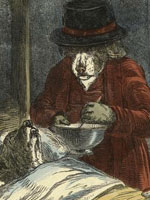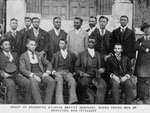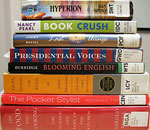Picturing America, a recent initiative from the National Endowment for the Humanities, contains a wealth of resources for using art in the classroom. The site contains links to four lesson plans that teach students how to analyze art, for example, teaching the basics of composition. The site contains over 20 pieces of art from various periods in U.S. history. A short essay with background information and analysis accompanies each piece of art. There are resource guides for using art, including a guide designed specifically for younger students.
Interactivity
This classroom tool—one of several history “interactives” on the Annenberg Media website—focuses on what a primary source is. Designed for students to work through either individually or in groups, this online resource is designed to help students read different kinds of primary sources for clues about their historical context. Using newspapers, journals, letters, and speeches, the site challenges students to test their document-reading abilities in an online game.
Teaching the Homebound or Hospitalized

Any good advice for a certified history educator who will possibly become a homebound/hospitalized teacher for children who are too ill to go to school? Thanks.
It can be a challenge to provide homebound and hospitalized students with the sort of interaction that other students receive each day in the classroom. Fortunately, the web puts numerous highly interactive activities within reach.
You'll find links to online resources throughout the Clearinghouse website, but here are a few that we think would work well for homebound students:
A number of museums have built excellent interactive history activities. The British Museum maintains a set of sites on ancient civilizations, and the Smithsonian's National Museum of American History has a collection of activities for kids to do at home. The Center for History and New Media recently partnered with the Smithsonian to create The Object of History, a site where visitors can manipulate artifacts, listen to curators talk about their role in history, submit questions, and curate a virtual exhibit of their own.
Many smaller museums offer more focused tools. For example, try the Plimouth Plantation's investigation into the first Thanksgiving.
The Monterey Institute has created a comprehensive online course in U.S. History that combines text and multimedia content delivery with interactive activities. You'll find it online at the HippoCampus website where you can set up a space for your own students, hide topics you don't want to cover, and bookmark ones you do.
You can also use the internet to give homebound students opportunities for social interaction. If you have multiple students covering the same material, try giving assignments that let them collaborate virtually. You could provide discussion prompts or projects that they would complete using email, instant messaging, or a discussion board.
Ask a school technology coordinator to help you install Course Management Software, or use one of the many collaborative web tools that have been developed in the last few years. Google Documents is good for collaborative writing, or you can register for a private wiki at WikiSpaces.com. They're flexible, easy to use, and free for teachers.
If you're really feeling adventurous (and if your students have access to fast Internet connections), think about using Skype voice chat or videoconferencing.
Data on Students' Knowledge of American History

I am trying to find current, national data on students' level of understanding and knowledge of American history. Any suggestions or studies that would help me find such data?
Good question! Unfortunately, there are not many sources for this kind of data. The best I know is the National Assessment of Educational Progress in American History. NAEP, referred to as the Nation's Report Card, is administered by an arm of the U.S. Department of Education and periodically assesses what students know and can do in various subject areas.
In U.S. history, fourth, eighth, and 11th graders across the nation take a test that includes multiple-choice and constructed-response questions. Here is the latest report on students' U.S. history knowledge and skills. This downloadable report presents the extensive data gathered by NAEP in easy-to-read formats. To learn more about the assessment and resulting data, see the varied links on the U.S. History home page. Scroll down and try the NAEP Data Explorer tool if you wish to explore and tailor the data available.
Tennessee's Social Studies Curriculum

When did Tennessee adopt a Social Studies curriculum? Have there been changes made over the years?
Tennessee, as far as we can tell, adopted its first curriculum framework during the 1982-83 school year. Previous to that effort, frameworks with standards were not formally articulated as they are today. James Akenson of Tennessee Tech (who was helpful in putting together this response), pointed out that the curriculum framework emerged at the same time as the "A Nation at Risk" report, which many scholars see as the birth of the standards movement. Those standards were in place until 1996, when they were revised for the first time. In 2001, a major revision effort took place under the direction of a committee of K-12 teachers, state department of education personnel, and representatives from higher education.
In crafting the Tennessee Social Studies Curriculum Standards, the group used the previous standards, the National Council for the Social Studies standards, current educational research, and curriculum frameworks from other states as guides. Finally, according to a representative in the state department of education, Tennessee will begin the revision process again prior to the next textbook adoption four years from the current (2009-2010) school year.
Constructivism: Actively Building Knowledge
![Photoprint, [Jess Dixon in his flying automobile], 1940, Kobel Feature Photos, Flickr Commons Photo, 1940, of Jess Dixon, Kobel Feature Photos, Flickr Commons](/sites/default/files/constructivism-150x113.jpg)
Is the theory of constructivism applied in today's history classroom and curriculum?
Constructivism is a broad theory with a variety of perspectives. However the basic tenet of constructivism is that learning is an active process where the learner constructs knowledge rather than acquiring it. The emergence of an inquiry-based approach to history education along with the new opportunities made possible by advances in technology have made constructivist approaches quite applicable in today’s history classroom.
There is a growing emphasis in history education on students being able to construct and analyze historical arguments. Many state standards, such as California’s History and Social Science Standards, call for students to be able to "construct and test hypotheses." Increasingly, both state standards and scholarship in history education are calling for students to analyze primary documents and assess various interpretations of the past.
Constructivism’s focus on the learner constructing knowledge might lead one to ask: what then is the role of the teacher? While students learn from experience from the constructivist view, a main function of the teacher is to shape those experiences. In many cases it is necessary for the teacher to provide scaffolds for students to construct knowledge. For example, sending students to an archive for an hour might not be the most productive way for them to learn how to construct an historical argument. Rather, providing them with a set of modified primary sources can create the conditions where students can begin to develop their own interpretations of the past.
Modeling how to construct an historical argument is also an important role of the history teacher. While an inquiry approach to history education is on the upswing, many students have been taught to simply recall facts. Modeling the complexity of constructing an historical interpretation based on evidence helps students develop their own historical interpretations.
Critics of constructivism fear that such an approach leads to completely subjective understandings of the past and fails to provide the common understandings of the past. Constructivists respond by saying that they are not proposing that students should discover just any ideas about the past, but rather that students develop the skills and dispositions to discern what to believe based on the available evidence.
Many constructivists also believe that students need to apply their understanding to concrete examples and point out that content standards can be mined for deeper concepts that in turn are exemplified by the several facts that are typically included in the content standards.
Technology facilitates constructivist’s approaches in the history classroom. Technology now offers unprecedented access to historical records and has made the goals of constructivism more attainable. Doolittle and Hicks (2003) outline six strategies for using technology to advance the basic tenets of constructivism in the social studies classroom. Theses strategies include using technology as a tool for inquiry, accessing authentic materials, and fostering local and global social interaction. Each strategy is accompanied by several websites that serve as exemplars.
Finally we should note that no single theory or approach should define a teacher’s practice. Students should inquire about the past, but history teachers still need to provide background materials for students. The theory of constructivism is not a prescription for how to teach, but rather provides a useful way for a teachers to think about their practice.
Here are some additional readings on constructivism and the history classroom:
Doolittle, Peter E. and David Hicks. "Constructivism as a Theoretical Foundation for the Use of Technology in Social Studies." Theory and Research in Social Education 31, no 1 (2003): 33.
Duffy, Thomas M. and Donald J. Cunningham. "Constructivism: Implications for the Design and Delivery of Instruction." In Handbook of Research for Educational Communications and Technology, edited by David H. Jonassen, 170-198. New York: Macmillan Library Reference, 1996.
Jadallah, Edward. "Constructivist Learning Experiences for Social Studies Education." Social Studies 91, no 5 (2000): 221–225.
Tackling Tough Topics
![India ink over pencil, [Section four. Liberty bonds getting kicked around and howling "I wanta go back to par"] (detail), February 15, 1921, Art Young, Library of Congress India ink and pencil, Section four. . . (detail), 1921, Art Young, LoC](/sites/default/files/TacklingTough150x113.jpg)
What are some of the difficult or charged issues that Social Studies teachers (grades 5-9) deal with? How can history teachers foster a sense of empathy among their students as a way of dealing with difficult or charged topics?
The broad scope of Social Studies that examines past and present human behaviors and interactions provides potentially rich topics for the Social Studies classroom. However, as a result of examining the human condition through such a broad lens, Social Studies teachers invariably encounter a variety of charged or difficult topics.
Issues around personal values, race, ethics, and stereotypes highlight just a few of the topics that can be potentially charged and consequently challenging for the Social Studies teacher. Teachers can also struggle with how to present controversial or contested interpretations of the past.
The Curriculum Guidelines for Multicultural Education issued by the NCSS recommends "Students should also be encouraged to examine alternative interpretations of the discrepancies between ideals and realities in the life and history of the United States."
The NCSS suggests that teachers provide students with a conceptual framework for understanding and identifying multiple perspectives. The Canadian Benchmarks of Historical Thinking offers some guidance for teachers to develop such frameworks for their students. The document describes the aspects of perspective taking as well as identifies two potential tasks that ask students to assume or critique perspectives.
Lastly, while some teachers find role-playing to be an effective way to teach perspective, other educators view such simulations as being superficial or potentially harmful to students. Regardless of what approach teachers use, students should be equipped with the skills necessary to identify and understand multiple perspectives about the past and present.
Here are some other resources that may be of use to Social Studies educators teaching difficult or charged issues:
Contingency

Can you please tell me a little bit more about the concept of contingency, and how it fits in with historical thinking skills? How can this concept be used with K-12 students? Any user-friendly references would be helpful too. I work in the field of teacher education and professional development.
Thanks for your question. Contingency is an important concept in understanding and investigating history and helping students develop historical thinking skills. Crudely defined, it is the opposite of inevitability. When students think that World War II or women's suffrage had to happen, that these events were destined to occur, they are ignoring the contingent nature of historical events. Contingency gets at how people in the past made history and how historic events and trends result from a variety of factors coming together—they are not preordained or unavoidable.
Contingency is key to historical thinking and helping students understand that while in hindsight, the past seems to unroll in logical storylines, this was not necessarily the case for those who lived through it. If suffragettes hadn't taken to the streets in the 1910s or focused on changing state laws, would they have won the vote in 1920? If the Treaty of Versailles contained different stipulations, would Germany have taken the path it did and would WWII have happened? Historical events are dependent (or contingent) on multiple causes that shape when, how, and why an event happened the way it did.
So contingency is deeply intertwined with understanding change over time—a framework many state standards and K-12 teachers use to focus and cohere their history courses.
Resources for explicitly teaching K-12 students this concept can be relatively sparse. But some do exist and they run the gamut, from instructional frameworks to particular activities. Historians Thomas Andrews and Flannery Burke suggest using the "5 Cs" to frame history instruction in this article. While their work was developed at the college-level, it can transfer (with modifications) to the K-12 classrooms. Their fourth "C" is contingency and they suggest it may be the most difficult to teach, but their description can help clarify the concept.
UCLA's National Center for History in the Schools also includes contingency in the historical thinking skills that students should be learning. Their standards assert that students should "Challenge arguments of historical inevitability by formulating examples of historical contingency, of how different choices could have led to different consequences." (see standard 3.G) These standards also remind us that discrete historical thinking skills are "interactive and mutually supportive" and cannot be taught in the absence of particular historical content.
See this lesson for an example consistent with these recommendations. Located at the Canadian Benchmarks of Historical Thinking site created by the University of British Columbia’s Centre for the Study of Historical Consciousness, it is a fine example of how to teach this concept. Focused on historical contingency, the lesson integrates this concept with the core historical concepts of causation and change over time to investigate the Chinese experience in Canada.
You will want to pay attention to instructional steps 1-7 and don’t miss the "outcomes" section at the end of the lesson. Not only does the lesson provide a coherent example of how you can take this concept into the classroom, it also succinctly describes how historic change is contingent on individual and group actions that are influenced and constrained by larger forces. It also uses two of our favorite ways to address contingency pedagogically:
- counterfactual questioning, or "what if" questions; and
- using cause and effect in a student's daily life to illustrate the concept before applying it to historic events.
For another example of a "What if" question, see this one about U.S. involvement in World War II or check out the series of "What if" books edited by Robert Cowley.
Contingency may be one of the harder historical thinking concepts to teach. To really grapple with it, students need to understand multiple causation and be able to think through change over time. But it's difficulty shouldn’t scare you away from teaching it as it is a critical link between history and civic preparation. As the National Center for History in the Schools says:
"A. . . trap is that of thinking that events have unfolded inevitably;that the way things are is the way they had to be, and thus that humankind lacks free will and the capacity for making choices. Unless students can conceive that history could have turned out differently, they may unconsciously accept the notion that the future is also inevitable or predetermined, and that human agency and individual action count for nothing. No attitude is more likely to feed civic apathy, cynicism, and resignation—precisely what we hope the study of history will fend off."
Writing Critiques of Primary and Secondary Sources

I have been asked to critique my primary and secondary sources at the end of
my paper. What should these critiques focus on and how long should they be?
Including the sources you consulted for a history paper is important. Your bibliography helps readers see what sources you used to make your claims and your argument. When each of the accounts is accompanied by commentary, we call that an annotated bibliography. This sounds similar to what your teacher wants for this assignment.
But before including some general guidelines for writing this addendum, let me suggest that you directly ask your teacher this question. This is the best way to find out your teacher's specific expectations. (It’s likely that some of your fellow students would also benefit from hearing those—usually when one student is confused, others are also.)
Having said that, here are some general guidelines:
- Keep each critique short. A few sentences are often sufficient and it should be no more than a paragraph.
- “Critique” in this case does not mean that you have to be negative about the source. Rather it means that you need to analyze and question each source.
- Use your own argument to help you choose how and where to focus your critique. Some questions that can help include:
- How did each source help you construct your argument and inform your synthesis of the sources? What sources stopped you in your tracks and made you reconsider how you were thinking? What sources reinforced your ideas?
- Did a source offer a new perspective or contradictory information? Which sources helped you with background knowledge or pointed you towards other useful sources to consult? How did this source’s content or perspective compare with other sources you consulted?
All of these questions can help you assess a source’s value for understanding your historical topic—the ultimate purpose of your critique.
Remember that when using a source from the time under study, you need to not only understand its content, you need to analyze that content. Ask questions of the source like: Who wrote it? When was it written? What was going on at that time? Who was the audience? What was the author’s purpose? Does the author use loaded words? Whose interests are represented by this source? These kinds of questions not only help you understand the source more deeply and accurately, they also help you critique it.
Similarly, you need to ask questions about any secondary source that you use. Start with asking: What is the author’s argument? What evidence does s/he use to make that argument? Does the evidence support the author’s argument? Also ask: Does the author consider alternative explanations and arguments? How does the account compare with other sources that you have consulted? Who is the author and does s/he have credentials or experience that make them trustworthy?
I am not suggesting that all of these questions should be answered in your critique, and indeed, given the brevity of each critique, that would be impossible. Rather they are examples of ways to assess the value of each source to your argument and the topic under study.
Finally, remember that if you judge a source “great,” “terrible” or with some other descriptor, include a specific statement about why it was great or terrible. For example, you might say something like, “This book was incredibly helpful” and then add the specific, “as it laid out the varied ways that historians have interpreted the conditions under slavery over the past 60 years.”
Good Luck!
Mary Lynn Rampolla, A Pocket Guide to Writing in History, Fourth edition, (Boston: Bedford St. Martin’s, 2004).